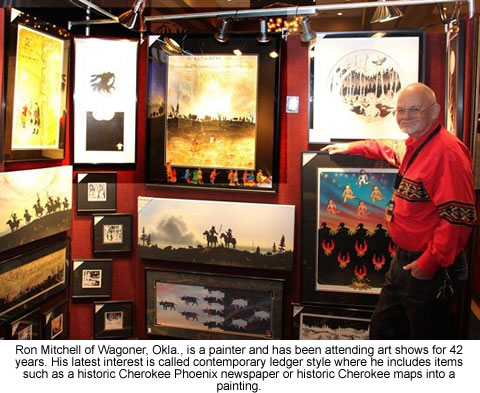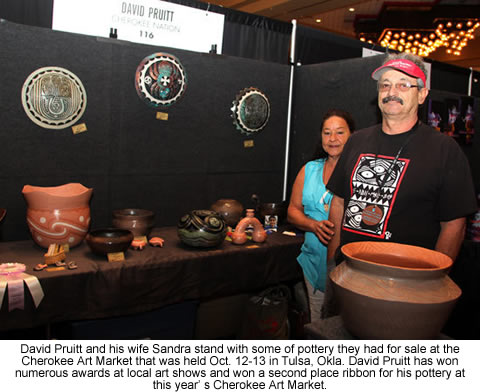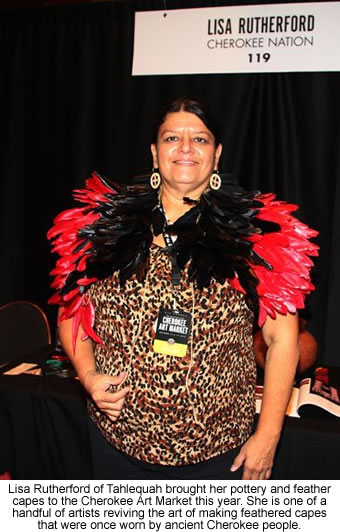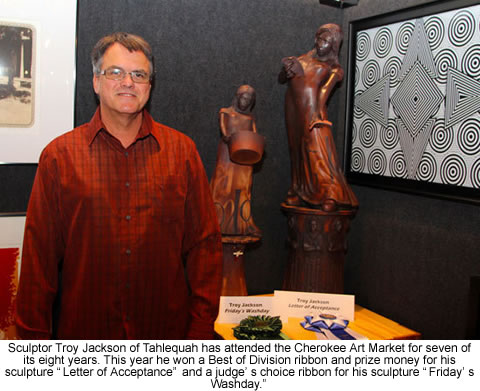 |
Canku Ota
|
 |
|
(Many Paths)
|
||
|
An Online Newsletter
Celebrating Native America
|
||
|
NOVEMber 2013 - Volume
11 Number 11
|
||
|
|
||
|
Local Artists Appreciate
Cherokee Art Market
|
||
|
by Will Chavez - Senior
Reporter, Cherokee Phoenix
|
||
|
credits: photos by Will
Chavez - Cherokee Phoenix
|
|
CATOOSA, OK. – The close proximity of the annual Cherokee Art Market allows local Cherokee artists to compete for prize money, show their art and hopefully sell some of it. This year, more than 150 Native American artists representing more than 45 tribes attended the event and competed for $75,000 in prize money. Artists competed in 20 categories that included beadwork, pottery, painting, basketry, sculptures and textiles.
Ron Mitchell of Wagoner is a painter who has attended art shows for 42 years. He stocked his booth at the market with paintings, including styles in his latest interest called contemporary ledger style where he adds items such as a historic Cherokee Phoenix newspaper or Cherokee maps into the painting. He said he's cut back on traveling to art shows since his wife died three years ago and recently moved back "into the Cherokee Nation" after living in Oklahoma City for 35 years. He said he appreciates having a quality art market close to home. "We have some of the best artists in the nation at this show. It's a small show, so people can get in and get around and see everything," he said. "It's the prize money that draws a lot of people here, and it makes it very competitive here. We do get a lot of tribal members from all over the country here, which makes it a good show."
David Pruitt of Peavine has attended the show for four years and this year won second place for his pottery. "This show is probably one of the biggest ones in the United States, besides the (annual Santa Fe, N.M.) Indian Market. There are Indians from all over the United States here that you compete against," he said. Some of his coil-built pottery has Cherokee designs. Many of the designs were found in burial mounds in southeastern United States, he said. Coil-built pottery is created by stacking coiled pieces of clay to create a circular wall of clay, which is then shaped into a pot. "We mix our own clay. A lot of it is hand-dug clay. We fire it traditionally," he said. He said a fire pit is used to fire his pottery. When the fire is at the right heat, he carefully places pots in it. Lisa Rutherford of Tahlequah took her pottery and feather capes to the Cherokee Art Market this year. She's one of a few artists bringing back the art of feathered capes. Her hand-coiled pottery is traditionally fired, and old textile imprints found on ancient pottery shards from the southeastern United States inspire some of her pottery designs.
"I replicated the twining from the old part shards and have been pressing into some of my pottery." Rutherford said the market continues to improve as the quality of art entered does. "This is a fairly big show. It attracts a lot of southwest artists. I would like to see more southeast artists. I think we need to capitalize on what we have here that makes us unique and promote our Cherokee, Keetoowah, Eastern Band (Cherokee) – all the southeast tribes," she said. Sculptor Troy Jackson of Tahlequah has attended the art market for seven of its eight years. "This is a top class market and competition. I think if holds one of the largest purses in Oklahoma, if not in the United States," he said. This year, he won a best of division ribbon and prize money for his sculpture "Letter of Acceptance" and a judge's choice ribbon for his sculpture "Friday's Washday."
"I've been doing sculpture now for about four years. I started out as a potter and my pottery kept getting more sculptural, so I thought I might as well do sculptures. So that's what I started doing," he said. Jackson said people have told him he's created a different style of sculpturing and his work "could not be considered ordinary." He sees his art as more contemporary when compared to traditional forms of Native sculpture. Artist Traci Rabbit of Pryor said she appreciates that market organizers bring in Native artists from throughout the country as well as locally. Rabbit attends art shows to sell her artwork and the artwork of her late father Bill Rabbit, a Cherokee National Treasure. She said the $75,000 in prize money is an incentive for artists to come to the Cherokee Art Market every October. "Of any of the shows I do, I believe this is probably the best prize money. I think that brings in higher caliber of artists from across the United States," she said. "I do travel coast to coast. It's nice to be able to do a home show, go home and sleep in my own bed..." She said the artists appreciate Cherokee Nation Businesses staff members who conduct the market and that the Hard Rock Hotel & Casino is a good venue. She also said the show makes locals aware of the Cherokee National Treasures and the art they create. |
||||||
|
|
||
|
|
||
| Canku Ota is a free Newsletter celebrating Native America, its traditions and accomplishments . We do not provide subscriber or visitor names to anyone. Some articles presented in Canku Ota may contain copyright material. We have received appropriate permissions for republishing any articles. Material appearing here is distributed without profit or monetary gain to those who have expressed an interest. This is in accordance with Title 17 U.S.C. Section 107. | ||
|
Canku Ota is a copyright ©
2000 - 2013 of Vicki Williams Barry and Paul Barry.
|
||
 |
 |
|
|
The "Canku
Ota - A Newsletter Celebrating Native America" web site and
its design is the
|
||
|
Copyright ©
1999 - 2013 of Paul C. Barry.
|
||
|
All Rights Reserved.
|
||




